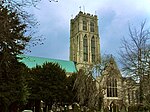Boothferry (UK Parliament constituency)
Parliamentary constituencies in Yorkshire and the Humber (historic)

Boothferry was a constituency in Humberside which returned one Member of Parliament (MP) to the House of Commons of the Parliament of the United Kingdom. It was created for the 1983 general election, and abolished for the 1997 general election.
Excerpt from the Wikipedia article Boothferry (UK Parliament constituency) (License: CC BY-SA 3.0, Authors, Images).Boothferry (UK Parliament constituency)
Ozone Park,
Geographical coordinates (GPS) Address Nearby Places Show on map
Geographical coordinates (GPS)
| Latitude | Longitude |
|---|---|
| N 53.736 ° | E -0.883 ° |
Address
Ozone Park
Ozone Park
DN14 7SE
England, United Kingdom
Open on Google Maps










